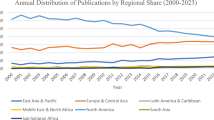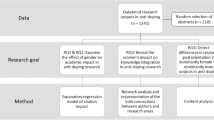Abstract
In order to analyse the gender disparities in scientific research output in the field of economics, this paper selected the Web of Science database as the source database. We collected and screened 257,642 articles written by 130,397 authors from 1933 to 2017 in the field of economics. In this study, we use mathematical statistics and bibliometrics indexes to quantitatively analyse the gap between male and female authors in many aspects, including the output and influence in different level of journals and institutions, the dynamic evolution of output and influence and collaboration modes with gender disparities. In addition, we have analyzed the disparities in output and influence of male and female authors among different countries. The results show that male authors dominate in the economics research field according to their high output and influence. However, female authors also show advantage when it comes to the research influence. Finally, we conducted a dynamic analysis of the contribution and collaboration of men and women over the course of their careers, and our findings again demonstrate the importance of women’s participation in scientific collaboration. This study can provide an insight of gender different in economics research.












Similar content being viewed by others
References
Abramo, G., D’Angelo, C. A., & Caprasecca, A. (2009a). The contribution of star scientists to overall sex differences in research productivity. Scientometrics, 81(1), 137–156.
Abramo, G., D’Angelo, C. A., & Caprasecca, A. (2009b). Gender differences in research productivity: A bibliometric analysis of the italian academic system. Scientometrics, 79(3), 517–539.
Abramo, G., D’Angelo, C. A., & Di Costa, F. (2018). The collaboration behavior of top scientists. Scientometrics, 118(1), 215–232.
Aksnes, D. W., Piro, F. N., & Rorstad, K. (2019). Gender gaps in international research collaboration: A bibliometric approach. Scientometrics, 120(2), 747–774.
Aksnes, D. W., Rorstad, K., Piro, F., & Sivertsen, G. (2011). Are female researchers less cited? A large-scale study of Norwegian Scientists. Journal of the American Society for Information Science and Technology, 62(4), 628–636.
Bertrand, M., & Mullainathan, S. (2004). Are Emily and Greg more employable than Lakisha and Jamal? A field experiment on labor market discrimination. American Economic Review, 94(4), 991–1013.
Blackwell, L. V., Snyder, L. A., & Mavriplis, C. (2009). Diverse faculty in STEM fields: Attitudes, performance, and fair treatment. Journal of Diversity in Higher Education, 2(4), 195–205.
Blickenstaff, J. C. (2005). Women in science careers: Leaky pipeline or gender filter? Gender and Education, 17, 369–386.
Caron, E., & van Eck, N. J. (2014). Large scale author name disambiguation using rule-based scoring and clustering. In Proceedings of the 19th international conference on science and technology indicators (pp. 79–86).
Drongstrup, D., Malik, S., & Hassan, S. (2019). Altmetrics study of economics. In 17th international conference on scientometrics and informetrics, ISSI 2019–Proceedings (vol. 1, pp. 984–989).
Fox, M. F. (2005). Gender, family characteristics and publication productivity among scientists. Social Studies of Science, 1(35), 131–150.
Garg, K. C., & Kumar, S. (2014). Boston profile of Indian scientific output in life sciences with a focus on the contributions of women scientists. Scientometrics, 98, 1771–1783.
Gaughan, M., & Bozeman, B. (2016). Using the prisms of gender and rank to interpret research collaboration power dynamics. Social Studies of Science, 46(4), 536–558.
Grant, S., Engers, M., Gans, J., et al. (1999). First author conditions. Journal of Political Economy, 107(4), 859–883.
Guglielmi, G. (2018). Gender bias tilts success of grant applications. Nature, 554(7690), 14–15.
Hamel, M. B., Ingelfinger, J. R., Phimister, E., & Solomon, C. G. (2006). Women in academic medicine—Progress and challenges. New England Journal of Medicine, 355(3), 310–312.
Jin, B., Wang, S., Ren, S., & Liu, Y. (1999). On the relationship between journal influencing factors and academic quality of papers. Chinese Journal of Scientific and Technical Periodicals, 11(4), 202–205.
Knobloch-Westerwick, S., Glynn, C. J., & Huge, M. (2013). The Matilda Effect in science communication: An experiment on gender bias in publication quality perceptions and collaboration interest. Science Communication, 35, 603–625.
Kyvik, S., & Teigen, M. (1996). Child care, research collaboration, and gender differences in scientific productivity. Science, Technology and Human Values, 21(1), 54.
Laband, D. N., & Tollison, R. D. (2000). Intellectual collaboration. Journal of Political Economy, 108(3), 632–662.
Larivière, V., Ni, C., Gingras, Y., Cronin, B., & Sugimoto, C. R. (2013). Bibliometrics: Global gender disparities in science. Nature, 504(7479), 211–213.
Li, L., & Wen, K. (2008). The review and revelation of promotion policies of women’s participation in science and technology in foreign countries. Journal of China Women’s University, 20(6), 75–80.
Lin, J. (1997). Introduction to research on gender differentiation in the scientific community. Collection of Women’s Studics., 2, 49–53.
Liu, Z., Zeng, Y., & Wang, T. (2014). Research on data model construction and core author mining of co-author relationship network. Software Guide, 12, 141–143.
Mauleón, E., & Bordons, M. (2006). The Productivity, impact and publication habits by gender in the area of materials science. Scientometrics, 66(1), 199–218.
Preston, A. E. (1994). Why have all the women gone? A study of exit of women from science and engineering professions. American Economic Review, 84, 1446–1462.
Qiu, J., & Wen, F. (2011). Correlation analysis on the relationship between the scientific collaboration degree among authors and the output of scientific research. Science and Technology Progress and Policy, 28(5), 1–5.
Rauber, M., & Ursprung, H. W. (2007). Life cycle and cohort productivity in economic research: The case of Germany. CESifo Working Paper, 9(4), 2–46.
Sandstom, U., & Van den Besselaar, P. (2018). Gender bias and cognitive proximity in grant allocation.
Sax, L. J., Hagedorn, L. S., Arredondo, M., & Dicrisi, F. A. R. (2002). Faculty research productivity exploring the role of gender and family-related factors. Research in Higher Education, 43(4), 423–446.
Schiebinger, L. (2014). Scientific research must take gender into account. Nature, 507(7490), 9.
Shi, Y., & Chen, X. (2011). Exploring the productivity of female sci-tech personnel research from a perspective of gender differences-based on the empirical research of Hubei Province. Journal of China Women’s University, 2, 60–65.
Sonnert, G., Fox, M. F., & Adkins, K. (2007). Undergraduate women in science and engineering: Effects of faculty, fields, and institutions over time. Social Science Quarterly, 88, 1333–1356.
Sotudeh, H., & Khoshian, N. (2014). Gender disparities in science: The case of scientific productivity in nano science and technology during 2005–2007. Scientometrics, 98, 457–472.
Sugimoto, C. R., Ni, C., West, J. D., & Larivière, V. (2015). The academic advantage: Gender disparities in patenting. PLoS ONE, 10, e0128000.
Svein, K., & Mari, T. (1996). Child care, research collaboration, and gender disparities in scientific productivity. Science Technology Human Values, 21(1), 54–71.
Van den Besselaar, P., & Sandström, U. (2016). Gender differences in research performance and its impact on careers: A longitudinal case study. Scientometrics, 106, 143–162.
Warner, B. J. (2014). The women’s leadership gap: Women’s leadership by the numbers. Center for American Progress. 1.
Woolley, A. W., Christopher, C. F., Pentland, A., Hashmi, N., & Malone, T. W. (2010). Evidence for a collective intelligence factor in the performance of human groups. Science, 330, 686–688.
Xie, Y., & Shauman, K. A. (1998). Sex differences in research productivity: New evidence about an old puzzle. American Sociological Review, 63(6), 847–870.
Yuan, Y. (2017). Gender differences in scientific research output of teachers in colleges and universities and their causes—based on the empirical analysis of pedagogy teachers in a research university. Higher Education Exploration, 3, 5–12.
Zeng, X. H. T., Duch, J., Sales-Pardo, M., Moreira, J. A. G., Radicchi, F., et al. (2016). Differences in collaboration patterns across discipline, career stage, and gender. PLoS Biology, 14(11), e1002573.
Zhang, J., & Zhang, D. (2008). The phenomenon of “relative absence” of women in scientific research–research on gender inequality in natural sciences. Science and Technology Progress and Policy, 1(25), 193–197.
Acknowledgements
We would like to express our thanks to Professor Cassidy R. Sugimoto and Professor Vincent Larivière in data collection and their commenting on an early draft of the paper. This research also received the financial support from National Science Foundation of China: Study on the Structure and Evolution of the Scientific Collaboration Network of Academicians from the Perspective of Symbiosis: A Case Study of Academicians of CAS and NAS under Grant No. 71603015. Also supported by the Natural Science Foundation of Beijing, China (Grant No. 9182001). Our gratitude also goes to the reviewers for their valuable comments.
Author information
Authors and Affiliations
Corresponding author
Rights and permissions
About this article
Cite this article
Liu, J., Song, Y. & Yang, S. Gender disparities in the field of economics. Scientometrics 125, 1477–1498 (2020). https://doi.org/10.1007/s11192-020-03627-x
Received:
Published:
Issue Date:
DOI: https://doi.org/10.1007/s11192-020-03627-x




